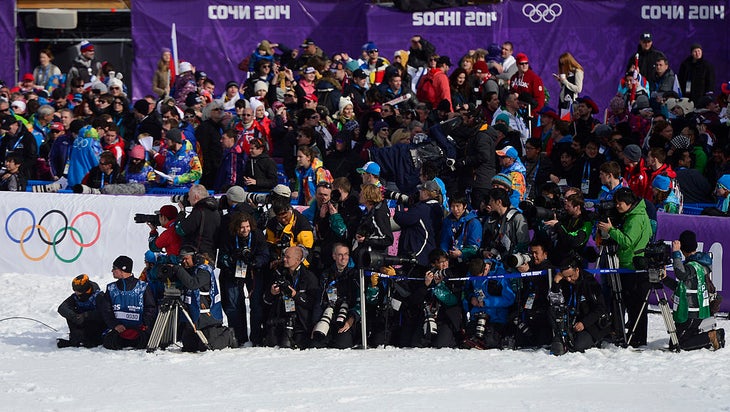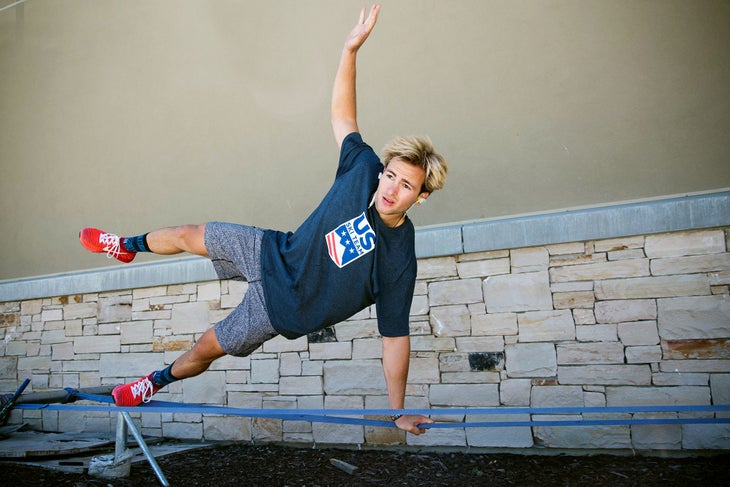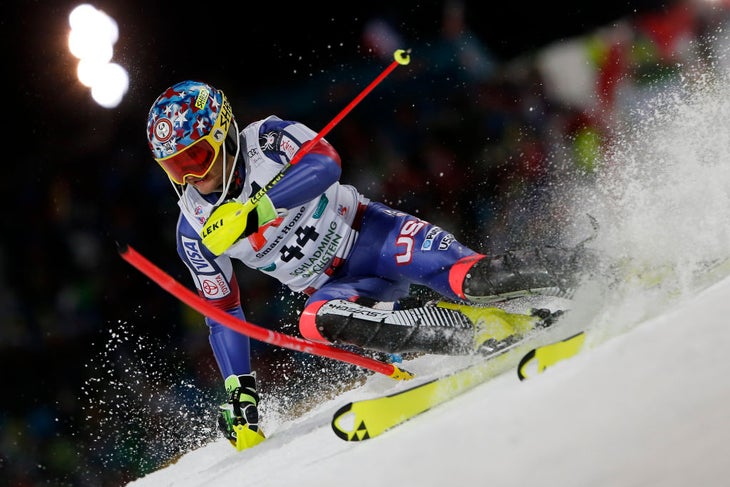Products You May Like
Tune into SKI’s Olympics homepage to stay up to date on all the stories and latest news from Beijing.
Athletes took many different roads to get to Beijing. AJ Ginnis may have taken the most unusual one. Ginnis has long dreamed of going to the Olympics, first as a member of the U.S. Ski Team, and, more recently, representing his native Greece. And he did indeed get to the Olympics, but not in the capacity he had planned. Due to a season-ending injury sustained in October, instead of carving his way down a slalom course in front of the TV cameras in Beijing, Ginnis will be off-camera serving as as an on-site expert and researcher for NBC. And for these unique Games, he’ll be one of very few.
Steve Porino, a former U.S. Ski Team downhiller, has been on NBC’s Olympic broadcast team since 2002. Under normal circumstances, he’d be broadcasting live from China himself during the Games. But due to the pandemic still raging worldwide, NBC decided to keep their announcing team in Stamford, Ct. throughout the Beijing Olympics. As a result, Ginnis will be NBC’s only in-person link to the alpine skiing action in China.
“Networks like NBC have expended tremendous effort and expense to be on the ground to hear, see, taste, and smell everything about the Olympic experience,” says Porino. In Sochi, for example, NBC had 104 people on the ground covering just alpine skiing. When NBC decided to stage the announcing team in Stamford rather than Beijing, Ginnis’s role expanded to that of a one-man band. “AJ, with one working leg, will be our eyes and ears on the hill, trying to place us there,” says Porino.

While Ginnis is grateful to be going to Beijing in any capacity at all, this is not how he imagined his Olympic debut.
Born in Athens, Greece, Ginnis learned to ski on Mt. Parnassus where his father ran the ski school. At age 12, Ginnis took up ski racing in Austria, where his dad worked. At age 15, the family moved to the U.S. where Ginnis then attended Vermont’s Green Mountain Valley School and, at age 17, became a member of the U.S. Ski Team. As a bronze medalist at the 2015 World Junior Championships—just behind current stars Henrik Kristoffersen and Marco Schwarz and ahead of a “Who’s Who” of current World Cup racers—Ginnis was on an early fast track. He won the U.S. national slalom title in 2017, and battled older teammates for World Cup starts while moving up the ranks.

In 2018, at age 23, he seemed on the cusp of breaking through on the World Cup. Then, due to budget constraints, the U.S. took the drastic measure of cutting its entire slalom team.
With sponsorship from Team Clif Bar, Ginnis forged ahead as an independent athlete, racing on the World Cup without the support of a national team. A knee injury (his third) derailed that season, but Ginnis roared back the following season, earning World Cup starts with the U.S. Ski Team, while also racing for Dartmouth on the NCAA circuit. He was headed back to Europe for more World Cup races when Covid brought the season to a screeching halt. When he was not nominated to the U.S. Ski Team later that spring, Ginnis enacted his plan B for making it to the top ranks of ski racing.
Related: Cut from the U.S. Ski Team, slalom racer Paula Moltzan battled her way to Beijing
With his portfolio of talent, languages, and relationships throughout the ski world, Ginnis had his pick of training partners, and a choice of citizenship. When the Greek Federation approached him about skiing for them, he jumped on board. “If I’m going to be paying my one way, I might as well have my own program and ski for Greece,” he figured. After getting released from the U.S. Federation, and with a commitment from Clif Bar, he hired his former GMVS classmate and U.S. Ski Team teammate Sandy Vietze as a coach, and set about raising the $100,000 per year needed to race independently.

“We had this super shoestring budget, where we relied on the help of friends on the hill and off,” says Ginnis. After an adjustment period of managing all their own fundraising, travel, and training, things started to come together by mid-January, 2021. Ginnis scored an 11th-place World Cup finish in Flachau, Austria, igniting the Greek fan base and asserting his podium potential.
After a productive summer of testing skis with Fischer and training with other national teams, Ginnis felt he had things dialed in and that the coming World Cup season would be his best yet. “It was definitely my best pre-season skiing,” he reflects. Then in October 2021, while warming up on the first day of a training block with the British team at an indoor ski facility in Belgium, he tore his ACL. In a moment his season, and his Olympic dream, were over.
Ginnis was devastated, but determined to come back to racing. In the meantime, he wanted to stay closely connected to the sport during the Olympics, and reached out to Porino to offer his services. While rehabbing his knee and finishing at Dartmouth, Ginnis started helping Porino with research for NBC, serving as a bridge between the athletes in his own network and the TV network. Soon he started receiving calls from people higher up at NBC, and eventually he landed a job with them in Beijing.
As an NBC sports analyst, Ginnis compiles all imaginable statistics related to the odds of winning medals in whatever scenario might unfold. “My goal is to provide any information that will make the commentators’ lives easier,” he explains. That involves monitoring and relaying conditions and events on the training and race venues, a role that is especially important in Beijing, where the entire venue is brand new, untested and unknown. Ginnis will also be stationed at the top of the course as the “start guy” (Porino’s usual role) on race day. And that’s just his day job; in the evenings, he’ll shift back to research, all while keeping up with his Dartmouth classes.
Ginnis, no stranger to pressure, is taking it in stride. “It’s a different kind of stress. I’ve never done this before, so I don’t really know what to expect. I’m happy to be there and making the best out of my situation.”
But that doesn’t mean Ginnis doesn’t have mixed emotions about going to Beijing as a spectator. “I really wanted to be there as an athlete,“ he says. “That was always my goal.” At 27, Ginnis is circumspect about his next Olympic bid. But it’s encouraging that British World Cup racer David Ryding, one of Ginnis’s training partners and a medal favorite in Beijing, got his first podium at age 30, and his first win this year, at age 35.
Already, Ginnis has gained perspective in watching his fellow athletes through the qualification process. “I feel like this definitely brings some sort of maturity to me as well. Hopefully I’ll be able to bring that into my athletics.” If all goes well, for Cortina 2026 Ginnis will be on the other side of the NBC cameras, where he belongs.
More Olympic Coverage
How China plans to become the next big ski nation
The controversial reason why the U.S. Olympic alpine team is so small
Who makes the fastest racers in the world even faster? These wizards
